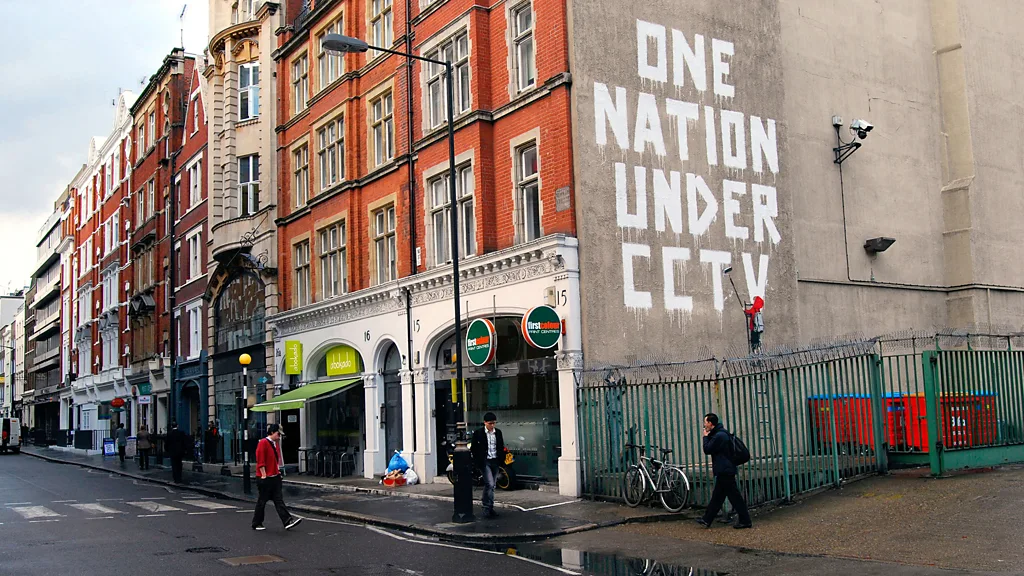Banksyの哲学的アート入門:影・希望・抵抗が語る深層メッセージ

Banksyは単なるストリートアーティストを超え、哲学的な問いを映像で表現することで世界的な注目を集めています。
本記事では、彼の代表作を通して、プラトンの洞窟の比喩やショーペンハウアーの意志、フーコーの監視社会論など哲学的テーマを学びます。
作品に込められた深い意味を理解しながら、現代社会の問題と人間の本質に迫ることができます。
Banksyのアートを通して哲学を楽しく学びましょう。
分からない単語や表現があっても、まずはひと通り読んでみてください。
Banksy’s artworks often engage deeply with philosophy, blending visual impact with intellectual inquiry. His latest mural in Marseille features a lighthouse shadow cast by a simple bollard, accompanied by the phrase, “I want to be what you saw in me.” This piece reverses Plato’s allegory of the cave by suggesting the shadow, usually a mere imitation, can embody a greater truth, prompting questions about identity and potential.
One iconic work, Girl with Balloon (2002), shows a child reaching for a drifting heart-shaped balloon with the phrase “there is always hope.” It reflects Arthur Schopenhauer’s concept of an unrelenting and irrational “Will,” driving human desire. Banksy amplified this by shredding the artwork during an auction, dramatizing the futility of longing.


In Flower Thrower (2003), a masked protester throws flowers instead of weapons, evoking Gandhi’s nonviolent resistance philosophy but with an ironic twist—beauty becomes a potent, explosive force rather than a pacifying one.
His 2007 piece One Nation Under CCTV critiques pervasive surveillance, echoing Michel Foucault’s concept of the Panopticon, illustrating society’s entrapment under constant watch.


Finally, Mobile Lovers (2014) highlights modern disconnection through a couple distracted by their smartphones. It channels Simone de Beauvoir’s existentialist call for authentic human connection, warning against a life dimmed by technology’s detachment.
Together, these works reveal Banksy’s persistent interrogation of identity, power, desire, and authenticity through philosophical lenses.
では、きょうの学習に進みます。
今回のニュースを理解するために、重要な単語の学習から始めます。
知っている単語であっても、ニュースの中では意外な使い方がされている場合もありますので、ひとつひとつ丁寧に確認するようにしましょう。
mural(名詞) /ˈmjʊərəl/
壁画、壁に描かれた絵画
街中で見ることが多い。Banksyの作品は多くがmuralである
allegory(名詞) /ˈælɪɡəri/
寓意、比喩的表現
哲学や文学で、抽象的な考えを具体的に表す際に用いる
shadow(名詞) /ˈʃædoʊ/
影
プラトンの洞窟の比喩で真実の象徴として登場
Will(名詞) /wɪl/
意志
特にショーペンハウアーの哲学で人間の欲望を動かす無意識の力
nonviolent(形容詞) /ˌnɑːnˈvaɪələnt/
非暴力の
ガンジーの抵抗運動に代表される
Panopticon(名詞) /ˈpænəptɪkən/
パノプティコン
フーコーが論じた監視の仕組み、常時監視される社会を象徴する
existentialist(形容詞) /ˌɛɡzɪˈstɛnʃəlɪst/
実存主義の
サルトルやド・ボーヴォワールの哲学に基づく
authentic(形容詞) /ɔːˈθɛntɪk/
本物の、真実の
実存主義で求められる自分らしさを指す
I want to be what you saw in me.
「あなたが私に見た(感じた)ものになりたい」
アイデンティティや他者からの評価と自己の関係を表現
There is always hope.
「いつも希望がある」
絶望的な状況でも希望を失わない心情を示す
One Nation Under CCTV.
「CCTV(監視カメラ)の下の一つの国家」
監視社会の皮肉な表現
Mobile Lovers
「モバイル愛好家」
現代のテクノロジーが人間関係に及ぼす影響を示す。
Banksy’s artworks often engage deeply with philosophy, blending visual impact with intellectual inquiry.
バンクシーの作品はしばしば哲学と深く関わり、視覚的なインパクトと知的な探求を融合させている。
His latest mural in Marseille features a lighthouse shadow cast by a simple bollard, accompanied by the phrase, “I want to be what you saw in me.”
彼の最新の壁画(マルセイユ)は、単純なポラード(車止め)が灯台の影を投げかけている様子を描き、「あなたが私に見たものになりたい」という言葉が添えられている。
This piece reverses Plato’s allegory of the cave by suggesting the shadow, usually a mere imitation, can embody a greater truth, prompting questions about identity and potential.
この作品はプラトンの洞窟の比喩を逆転させている。通常は模倣に過ぎない影が、より大きな真実を体現し得ることを示し、アイデンティティや可能性についての問いを投げかけている。
One iconic work, Girl with Balloon (2002), shows a child reaching for a drifting heart-shaped balloon with the phrase “there is always hope.”
代表作『風船を持つ少女』(2002年)は、流れていくハート型の風船に手を伸ばす少女を描き、「いつも希望がある」という言葉が添えられている。
It reflects Arthur Schopenhauer’s concept of an unrelenting and irrational “Will,” driving human desire.
これは、アーサー・ショーペンハウアーの終わることのない非合理的な「意志」が人間の欲望を動かすという考えを反映している。
Banksy amplified this by shredding the artwork during an auction, dramatizing the futility of longing.
バンクシーはオークション中に作品をシュレッダーで切断し、切望の無意味さを劇的に表現した。
In Flower Thrower (2003), a masked protester throws flowers instead of weapons, evoking Gandhi’s nonviolent resistance philosophy but with an ironic twist—beauty becomes a potent, explosive force rather than a pacifying one.
『花を投げる人』(2003年)では、覆面の抗議者が武器の代わりに花を投げる。ガンジーの非暴力抵抗を想起させるが、皮肉にも美しさは和解させるのではなく強力な爆発力を持つ力として描かれている。
His 2007 piece One Nation Under CCTV critiques pervasive surveillance, echoing Michel Foucault’s concept of the Panopticon, illustrating society’s entrapment under constant watch.
2007年の作品『One Nation Under CCTV』は、広範囲に及ぶ監視社会を批判し、ミシェル・フーコーのパノプティコンの概念を反映させている。常時監視されることで社会が閉じ込められていることを示している。
Finally, Mobile Lovers (2014) highlights modern disconnection through a couple distracted by their smartphones.
最後に、『モバイル・ラバーズ』(2014年)は、スマートフォンに気を取られるカップルを通じて現代の断絶を浮き彫りにしている。
It channels Simone de Beauvoir’s existentialist call for authentic human connection, warning against a life dimmed by technology’s detachment.
これはシモーヌ・ド・ボーヴォワールの実存主義的な真の人間関係への呼びかけを表現し、テクノロジーによる疎外により輝きを失った生を警告している。
Together, these works reveal Banksy’s persistent interrogation of identity, power, desire, and authenticity through philosophical lenses.
これらの作品は総じて、哲学的視点からアイデンティティ、権力、欲望、真実性についてバンクシーが一貫して問い続けていることを示している。
最後に、今回の学習内容の理解度チェックです。ぜひトライしてみてください。
次の英文を読んで、空欄に入る最も適切な選択肢を選んでください。
Q1. __ is a concept by Michel Foucault criticizing pervasive surveillance.
(A) Allegory
(B) Panopticon
(C) Will
(D) Nonviolent
- 答えはここをクリック
-
解答(B)
Panopticonはフーコーの監視社会の概念で、常時監視の構造を指す。
Q2. In the phrase “I want to be what you __ in me,” which verb correctly completes the sentence?
(A) see
(B) saw
(C) sees
(D) seeing
- 答えはここをクリック
-
解答(B)
「過去にあなたが私に見たものになりたい」という意味で過去形の”saw”が正しい。
Q3. Which Banksy artwork involves shredding to symbolize the futility of desire?
(A) Mobile Lovers
(B) Flower Thrower
(C) Girl with Balloon
(D) One Nation Under CCTV
- 答えはここをクリック
-
正解:(C)
Girl with Balloonはオークションで破壊され、欲望の虚しさを示した。
Q4. Gandhi’s philosophy evoked in Flower Thrower is mainly about __.
(A) Violence
(B) Surveillance
(C) Nonviolence
(D) Hope
- 答えはここをクリック
-
正解:(C)
Flower Throwerは非暴力を象徴している。
Q5. Simone de Beauvoir’s existentialism emphasizes __.
(A) Authentic human connection
(B) Physical strength
(C) Material wealth
(D) Political power
- 答えはここをクリック
-
正解:(A)
ド・ボーヴォワールは実存主義で真の人間関係を重視した。
Banksyの作品は単なるアートではなく、深い哲学的な問いを投げかけるメッセージとして私たちに迫ります。
プラトンやショーペンハウアー、フーコー、ド・ボーヴォワールといった思想を背景に、アイデンティティや欲望、監視、真実の意味を考えさせます。
彼のアートから学ぶことで、現代社会の問題を違った角度から理解し、自分自身の内面を見つめ直すヒントが得られるでしょう。
これを機に、哲学とアートの融合を楽しみながらさらなる学びを進めてみてください。



